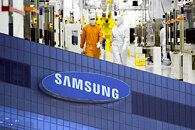- Joined
- May 21, 2024
- Messages
- 1,482 (3.60/day)
Samsung Electronics is speeding up its work on 2 nm production facilities, industry sources say. The company has started to install advanced equipment at its "S3" foundry line in Hwaseong to set up a 2 nm production line. This line aims to produce 7,000 wafers each month by the first quarter of next year. Also, Samsung plans to create a 1.4 nm production line at its "S5" foundry in Pyeongtaek Plant 2 by the second quarter of next year. This line has a goal to make 2,000 to 3,000 wafers each month. By the end of next year, Samsung will change all the remaining 3 nm production lines at "S3" to 2 nm.
As we reported earlier, Samsung has pushed back the start date for its Tyler, Texas foundry. The plant set to open by late 2024, won't install equipment until after 2026. Also, Samsung has changed its plans for the Pyeongtaek Fab 4 foundry line. Because of lower demand, it will now make DRAM instead, moreover, at Pyeongtaek Fab 3, which has a 4 nm line, Samsung has cut back production. These changes are part of Samsung's plan to make 2 nm chips next year and 1.4 nm chips by 2027. The company wants to catch up with its rival TSMC, right now, Samsung has 11.5% of the global foundry market in Q2, while TSMC leads with 62.3%. An industry expert stressed how crucial this is saying, "With the delay in 3 nm Exynos production and other issues, getting the 2 nm process right could make or break Samsung Foundry". The struggle for Samsung is real, with the company's top management, led by DS Division Vice Chairman Jeon Young-hyun, having recently issued a public apology for the division's underwhelming performance.

View at TechPowerUp Main Site | Source
As we reported earlier, Samsung has pushed back the start date for its Tyler, Texas foundry. The plant set to open by late 2024, won't install equipment until after 2026. Also, Samsung has changed its plans for the Pyeongtaek Fab 4 foundry line. Because of lower demand, it will now make DRAM instead, moreover, at Pyeongtaek Fab 3, which has a 4 nm line, Samsung has cut back production. These changes are part of Samsung's plan to make 2 nm chips next year and 1.4 nm chips by 2027. The company wants to catch up with its rival TSMC, right now, Samsung has 11.5% of the global foundry market in Q2, while TSMC leads with 62.3%. An industry expert stressed how crucial this is saying, "With the delay in 3 nm Exynos production and other issues, getting the 2 nm process right could make or break Samsung Foundry". The struggle for Samsung is real, with the company's top management, led by DS Division Vice Chairman Jeon Young-hyun, having recently issued a public apology for the division's underwhelming performance.

View at TechPowerUp Main Site | Source






